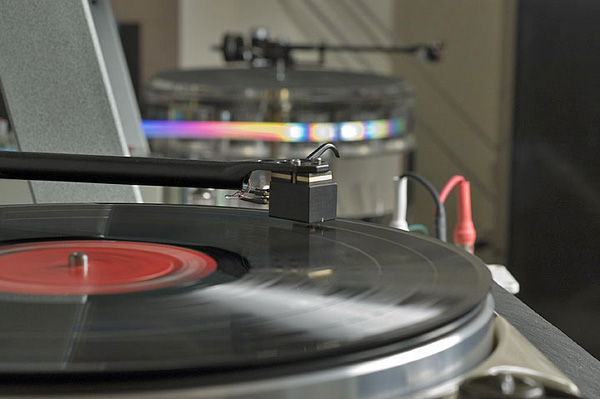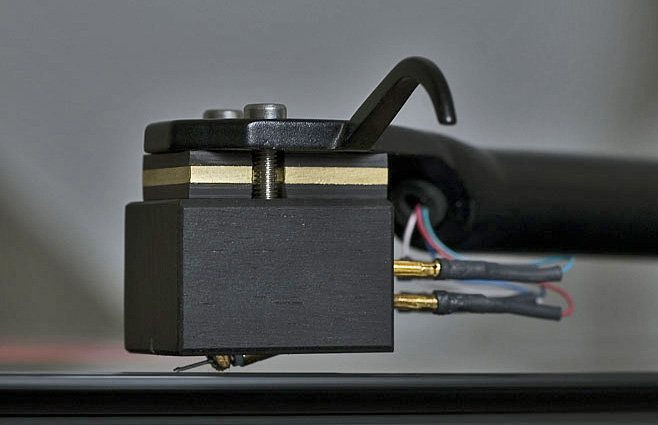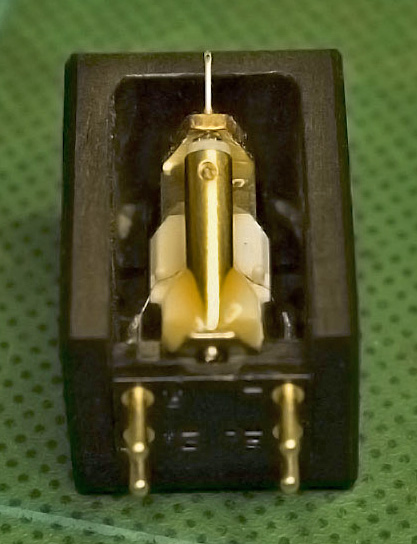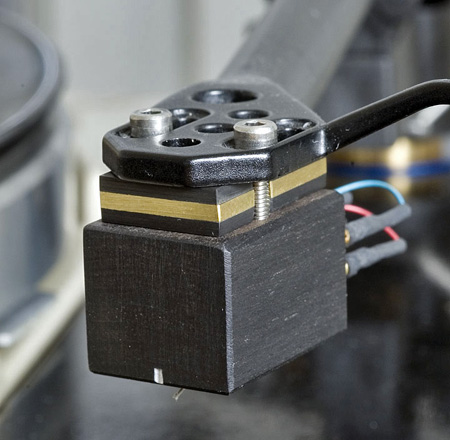-edible zone-
*
*
The doing: For this exercise I did not make a photo essay on plastic body removal and wooden body installation. This has already been done in an online video produced and offered freely by Thomas Schick. I merely watched his video a couple of times, which, by the way, is excellent, and then I knew enough to carry out the procedure. Unfortunately, as of this edit, (7/2023) The link is no longer active.
At a later time I installed a Uwe ebony body on a DL-103 for the client on the 34259 build. So I offer these here giving a window into the process of exchangeing bodys. The DL103 and DL103R are dimensionally the same.
(click thumbnail for full size image)
Below 4 shots: DL103 into a Uwe ebony body.
* DL103R in Uwe ebony
DL103R in Uwe ebony
Risk Disclaimer: Be aware, it is very easy to destroy one of these cartridges with one mistake.... or a slip! The DL-103R costs approximately $270 direct from Japan at the time of this writing.
*
Preliminaries:
The previous experiment of adding mass to the
otherwise standard DL-103R, in order to better mate it to the
Expressimo/Rega tonearm, had proven to me that this cartridge really
wants a fairly heavy tonearm before it will begin to sing its song good
and proper. To review, I had gone to some length to add mass to this
Expressimo/Rega tonearm and that I really liked the end result with the
plastic bodied DL-103R. But now I'm adding the Ebony body which is
advertised at 4 grams by itself.
 From what I'd previously learned, I anticipated that I would want to
retain the headshell weight along with this weightier Ebony body. So
far, more mass = better.** Btw, using the hfnrr test record, my
horizontal arm/cart resonance is still between 10 - 11hz. Even with this
added weight the arm/cart resonance is easily within the optimal zone.
I'm beginning to suspect that the Denon DL-103R might work best on an
arm with an effective mass of between 16 to 20 grams. If so there is
room to go heavier than it is now.
From what I'd previously learned, I anticipated that I would want to
retain the headshell weight along with this weightier Ebony body. So
far, more mass = better.** Btw, using the hfnrr test record, my
horizontal arm/cart resonance is still between 10 - 11hz. Even with this
added weight the arm/cart resonance is easily within the optimal zone.
I'm beginning to suspect that the Denon DL-103R might work best on an
arm with an effective mass of between 16 to 20 grams. If so there is
room to go heavier than it is now.
The fit up was easy. The Ebony body contains threaded holes for M2.5.
(m2.5 x .45mm (dia. and pitch)) Ergo.....no nuts. Two hands can do it.
Even though the Denon stylus protector is no longer functional on this
custom Ebony body, its blocky shape proved helpful in safe handling, and
I managed to keep my thick fingers and thumb off the fragile cantilever.
A quick alignment session to set overhang, zenith angle and check
azimuth was straight forward and successful. Using a small mirror it was
evident that the new body did not present any apparent issues of azimuth
alignment. A critical factor since the Rega arm offers no adjustment for
this parameter. Great. That was easy. Now for some listening.
Listening:
The removal of the thin plastic body and the
replacement of it with a more substantial one in Ebony. How much should
this affect the sound quality of any cartridge? My ears tell me that in
this situation it nets a pretty significant difference. In short; The
overall sonic character of the cartridge remains but is enhanced. High
frequencies become more extended while gaining clarity and definition.
There is a greater sense of ease and flow combined with cleaner details.
There is more air around each note. While not an analytical, detail
extracting cartridge, it does dig out some fine, faint details not
previously heard. Unexpected. There is a touch more weight to the lower
frequencies while improving definition of timbre and texture in that
area.
What I really like about this cartridge is that it is not
at all ruthless or revealing of the recording quality of any Lp. In fact
it seems to ignore poor recordings and simply dig out the music in a
very enjoyable presentation. I love it for 60's and 70's pop/rock
albums. An excellent, play-it-loud, rock and roll cartridge. And yet it
does justice to acoustic instruments and the human voice making these
performances intimate. I find myself playing jazz Lps with this rig
quite often. And for now I think I'll forget trying to analyze the sound
and and just enjoy the foot-tappin good music. You can lose yourself in
it.
In short summary it seems as though this budget cartridge has
been transformed into one very enjoyable music machine for less than
$400 total invested.
Caveats:
This design is from 1962.
And was matched to quality tonearms of that day. In today's terms It
wants a medium-mass to medium-high-mass tonearm and, like all low output
MC cartridges, it requires either a purpose made active MC phono stage,
or it will need a passive step-up transformer in line between the
cartridge and any 47K ohm phono stage. This area of the setup will have
a profound effect on the sound quality that is heard!!
_____________horizontal rule
Footnotes:
** Denon lists compliance of its DL-103R tubular
aluminum cantilever to be 5x10-6cm/dyne (tested @ 100 hz) On paper this
seems rather stiff!! This has been a source of confusion for audiophiles
who relate to stated compliance values that are tested at the more
common 8 - 12 hz resonance testing range using test records such as the
HFNRR test record. What has been found by many current users of this
cartridge is that when paired to today's medium mass tonearms the
DL-103R will test to be within the optimal 8 - 12hz zone noted for
arm/cart resonance. The indications are that the cartridge more likely
has a compliance of around 10-11 x10-6cm/dyne when resonance tested at
11 hz. This is fairly normal and works with medium mass or heavier
tonearms.

